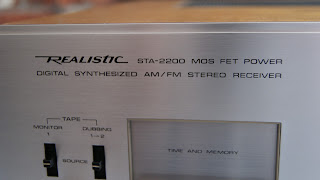Now this is a rare gem! Before you snub your nose at the Realistic name, the question you have to ask yourself is who made it for Radio Shack? Well, the answer is simple, very simple. This is a Mosfet amplifier and there was only one company to use mosfet technology back in the late 70s and early 80s, that was Hitachi! This is a Hitachi made receiver for Radio Shack, and is one sweet sounding amplifier!
Many may recognize it as the receiver sitting on top of my component stand. It sat there for more than a half of year and I don't think I've really used it except on a couple occasions. And, if I haven't used it in the past 6 months, it's time to part ways with it.
So what's so special about mosfet? It has a strong resemblance to the good old tube sound without the added harmonics and distortions. Which means, its softer in presentation in comparison to their bi-polar transistors with a lovely mid range frequency. Bass and treble are still very nice, but the mid range is what makes this amp sound so very nice! It sounds as it's a bit U-shaped in it's sound frequency.
But, there are plenty of features on this baby, such as a built in clock! It's also features a digital tuner and Dolby FM. Because it's a digital tuner, you also have memory presets. And, of course to give it more beautiful lights other than the blue display, a digital VU meter underneath the display! Also features a main in and pre-out if you wish to use it as a power amplifier.
Oh, and it's rated at 60wpc into 8ohms and is built really well, and heavy too! Matches well with brighter sounding speakers, at least that's how I would match a set.
Overall, it's in good condition, it is missing the plastic trim on the sides and the woodcase has a few chips. But, it is still very presentable and sounds great!
Lots of information on the internet!
Many may recognize it as the receiver sitting on top of my component stand. It sat there for more than a half of year and I don't think I've really used it except on a couple occasions. And, if I haven't used it in the past 6 months, it's time to part ways with it.
So what's so special about mosfet? It has a strong resemblance to the good old tube sound without the added harmonics and distortions. Which means, its softer in presentation in comparison to their bi-polar transistors with a lovely mid range frequency. Bass and treble are still very nice, but the mid range is what makes this amp sound so very nice! It sounds as it's a bit U-shaped in it's sound frequency.
But, there are plenty of features on this baby, such as a built in clock! It's also features a digital tuner and Dolby FM. Because it's a digital tuner, you also have memory presets. And, of course to give it more beautiful lights other than the blue display, a digital VU meter underneath the display! Also features a main in and pre-out if you wish to use it as a power amplifier.
Oh, and it's rated at 60wpc into 8ohms and is built really well, and heavy too! Matches well with brighter sounding speakers, at least that's how I would match a set.
Overall, it's in good condition, it is missing the plastic trim on the sides and the woodcase has a few chips. But, it is still very presentable and sounds great!
Lots of information on the internet!





